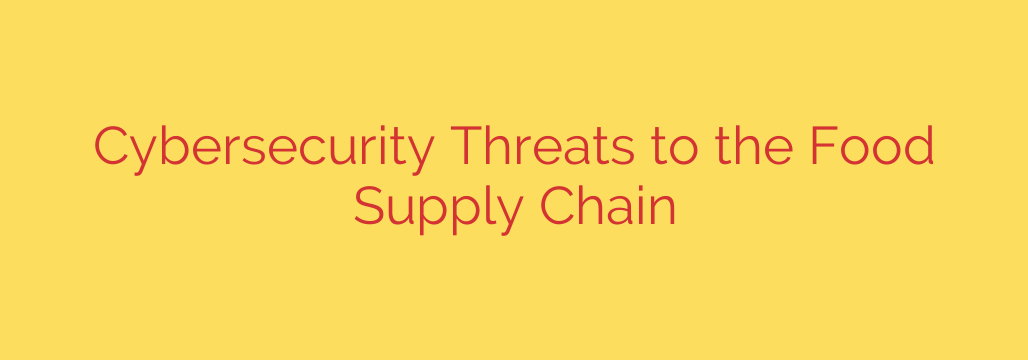
Securing Our Plates: Navigating the Rising Cybersecurity Threats in the Food Supply Chain
The journey of our food from farm to fork is a modern marvel of logistics, technology, and precision. But this complex, interconnected system has a hidden vulnerability that poses a significant risk to our economy and daily lives: cybersecurity. As the food and beverage industry becomes more digitized, it is increasingly becoming a prime target for malicious cyberattacks.
From processing plants to distribution networks, the entire food supply chain relies on technology. A successful cyberattack doesn’t just mean a data breach; it can mean production halts, spoiled goods, and empty grocery store shelves. Understanding these threats is the first step toward building a more resilient and secure food future.
Why the Food Supply Chain is a Hacker’s New Favorite Target
Cybercriminals are strategic, and they target industries where they can cause the most disruption for the biggest payout. The food and beverage sector has unfortunately become a perfect mark for several key reasons:
- Critical Infrastructure: Food is essential. Attackers know that any disruption creates immense pressure on a company to resolve the issue quickly, making them more likely to pay a ransom.
- High-Stakes Operations: In food production, downtime is not just an inconvenience—it’s incredibly costly. Perishable goods can spoil, production lines can be damaged, and contracts can be lost, creating a powerful incentive to give in to attackers’ demands.
- Growing Digital Footprint: The industry has widely adopted automation, IoT sensors, and connected systems to improve efficiency. While beneficial, this digital transformation expands the potential attack surface, giving hackers more doors to try and open.
- Interconnected Systems: A single vulnerability in a third-party logistics provider, a packaging supplier, or a farm management software can create a domino effect, compromising larger partners up the chain.
Top Cybersecurity Threats to the Food and Beverage Industry
While the motivations are clear, the methods of attack are varied and sophisticated. Companies in the food supply chain must be prepared to defend against several key threats.
1. Ransomware Attacks
This is arguably the most significant and disruptive threat. In a ransomware attack, malicious software encrypts a company’s files, rendering systems and machinery inoperable. The attackers then demand a hefty payment, usually in cryptocurrency, to restore access. For a food processor, this can mean a complete shutdown of plant operations, leading to millions in lost revenue and wasted products.
2. Operational Technology (OT) and ICS Vulnerabilities
Beyond standard IT networks (like email and servers), food companies rely heavily on Operational Technology (OT) and Industrial Control Systems (ICS). These are the systems that control the physical machinery: mixers, ovens, packaging lines, and refrigeration units. An attack targeting OT could:
- Shut down production lines.
- Alter recipes or formulas, compromising food safety.
- Manipulate temperature controls, leading to widespread spoilage.
- Cause physical damage to expensive equipment.
Securing OT is critical because it represents the line where digital threats become physical problems.
3. Phishing and Social Engineering
The most common entry point for any cyberattack remains the human element. Phishing attacks use deceptive emails, texts, or messages to trick employees into revealing login credentials or downloading malware. A single employee clicking a malicious link can be enough to give an attacker a foothold inside the entire corporate network, from which they can launch a much larger attack like ransomware.
4. Supply Chain and Third-Party Risks
Your organization is only as secure as your weakest link. Hackers often target smaller, less-secure vendors—like logistics partners, ingredient suppliers, or maintenance contractors—to gain access to the networks of their larger clients. Vetting the security practices of all third-party partners is no longer optional; it’s an essential part of a modern defense strategy.
Building a Resilient Defense: Actionable Security Measures
Protecting the food supply chain requires a proactive, multi-layered approach to security. Waiting for an attack to happen is not a viable strategy. Here are essential steps every organization in the food and beverage industry should take:
- Conduct Comprehensive Risk Assessments: You can’t protect what you don’t know. Regularly assess your entire technology environment, including both IT and OT systems, to identify and prioritize vulnerabilities.
- Segment Your Networks: One of the most effective defensive tactics is network segmentation. Keep your critical OT network separate from your corporate IT network. This way, even if a phishing attack compromises an office computer, the attacker can’t easily pivot to shut down your plant floor machinery.
- Prioritize Employee Training: Your employees are your first line of defense. Implement ongoing security awareness training that teaches them how to spot and report phishing attempts and follow security best practices.
- Implement Robust Access Controls: Enforce the principle of “least privilege,” ensuring employees only have access to the data and systems they absolutely need to do their jobs. Enable multi-factor authentication (MFA) wherever possible to add a critical layer of security to user accounts.
- Develop and Test an Incident Response Plan: Have a clear, actionable plan for what to do when an attack occurs. This plan should define roles, communication strategies, and steps for containment and recovery. Practice this plan with tabletop exercises so everyone knows their role when a real crisis hits.
- Maintain and Patch Systems: Ensure all software, firewalls, and operating systems are consistently updated and patched to protect against known vulnerabilities.
The security of our food supply is a shared responsibility. By taking these threats seriously and investing in robust cybersecurity measures, companies can protect their operations, their customers, and the integrity of the food on our plates.
Source: https://www.helpnetsecurity.com/2025/07/30/agri-food-sector-cybersecurity/








